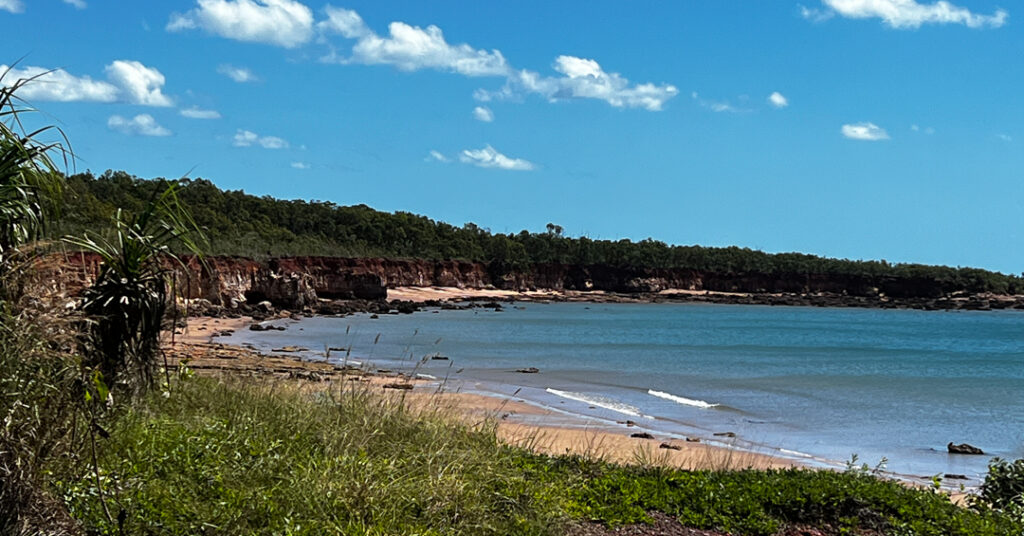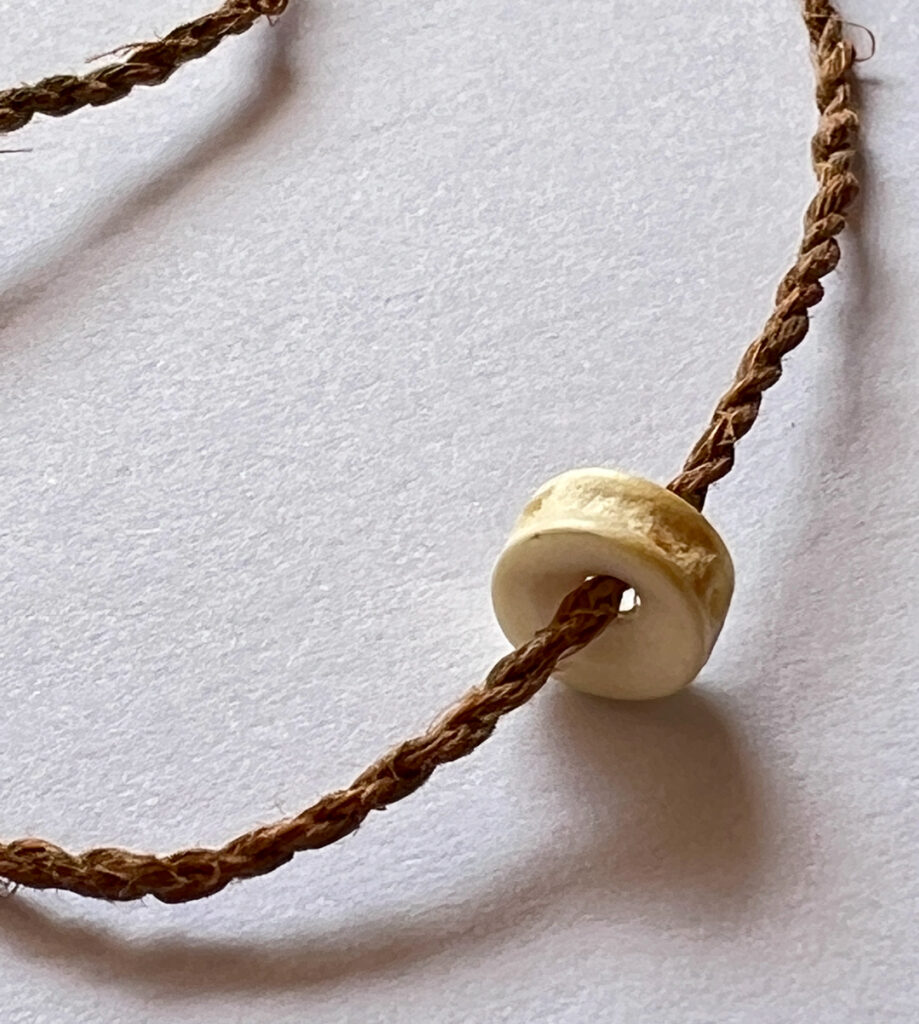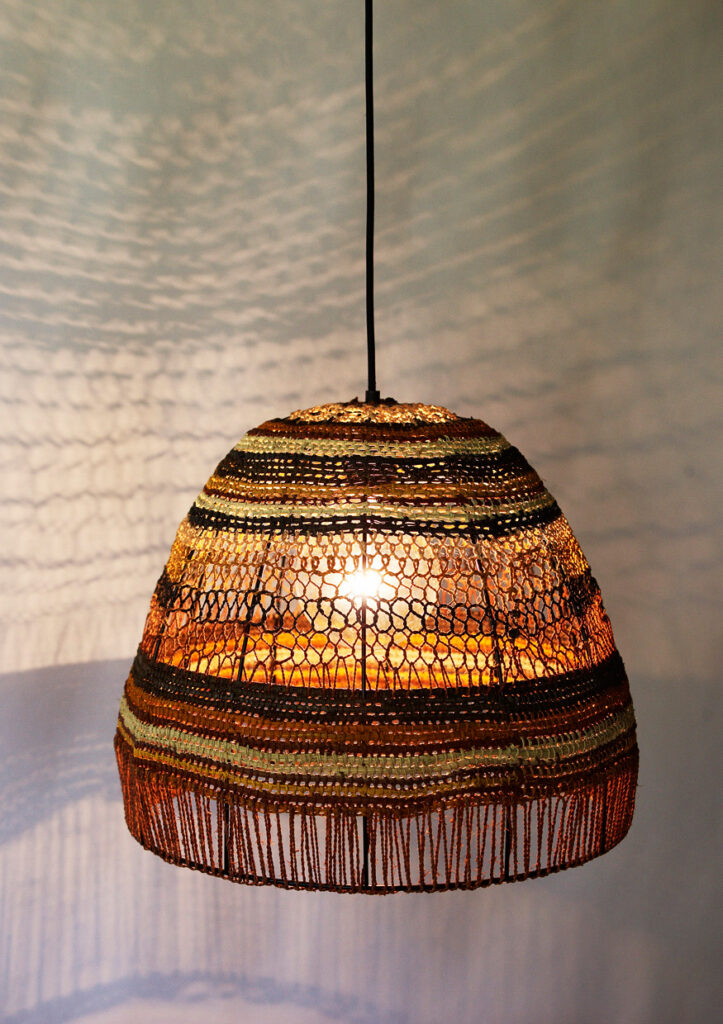
Louise Hamby reflects on the important life and career of an elder and master weaver from Elcho Island.
It is with sadness that I am writing this tribute about my gathu, Mavis Warrngilna Ganambarr. She had much more to offer to her family, her friends and her audience of devoted fans. She was a star and it is a privilege to be able show what a guiding light she was to other artists not just at Elcho, Galiwin’ku, in northeast Arnhem Land, but in the greater artistic community through her work. She always wanted to support the younger generation. This desire was evident even when I first met her in 2001. “It is time for us to do what our people have done in the past so that our children and their children will recognize our work in the future when they see it.”
In November 2001 I met her in Sydney at her solo exhibition, Gunga Djama Mirr (Pandanus Work), at Bandigan Gallery. It was a momentous occasion to see such a large number of works (81) all by a single First Nations woman artist on display, most of them complex items to be worn on the body. Although this exhibition title implies it was about objects made from pandanus, it also contained feathered armbands (18) and matching sets of necklaces and earring sets (3), earrings (37) and necklaces (11), all made from natural materials. Five of the necklaces were long; composed of red bead tree seeds and shells. This versatile body of work came about through ‘Mavis coming up with some inspiring things’. This exhibition was facilitated by Brenda and Steve Westley, then art coordinators at Elcho Island Arts and Crafts who had a vision of the powerful legacy that she would have in years to come.

Mavis Ganambarr, Hat from pandanus with shells and abruus seeds. 2003. Photo: Louise Hamby Collection.
After our first meeting, a strong interest in her own history and my passion for museum collections of material culture brought us together on a number of occasions. This shared pursuit started through an Australian Research Council Grant, with Lindy Allen, then Senior Curator Museum Victoria, on the Donald Thomson Collection. The photographs taken by Donald Thomson provided a visual link to her father, Mowarra Ganambarr OAM. He and his brother Ŋoŋu or Daypurran were identified by relatives at Gangan in two sets of images taken five years apart. Mavis was delighted to see Donald Thomson’s photographs of her fathers. Both men were members of the Northern Territory Special Reconnaissance Unit during WWII. Her Dätiwuy family are strong artists as evidenced by the bark paintings completed by her father and collected by Thomson in 1942. After WWII, Mata Mata homeland an early outstation was established by Yolngu elders, including Mavis’s father and the pioneering aviator missionary Harold Shepherdson who established the runway making it accessible. It was there that Mavis was born in 1966.
Harold Shepherdson continued to play a role in her life as he brought her to Galiwin’ku.
Bapa Shepie brought me to Galiwin’ku when I was 9 years old so I could go to school. I was taught fibre art by my grandmother Djuluka when I was 19 years of age and I have been continually creating weavings and wearable art since then. I am very proud of what my grandmother taught me to do, but now I am making different, new styles of my own ideas. I teach my children and one day they will teach their children. In this way we will keep our culture strong. (Elcho Island Arts)
Mavis’s art practice in different media grew from the experience she had with her close kin and others on Elcho Island, especially the late Rose Mamuniny. Dominating Mavis’s artistic works were her fibre creations.
Mavis did make what one might consider classic fibre forms like coiled and twined baskets and mats that developed into more complex forms and exciting projects, but it was her work with bodywear and jewellery that started an association working with the jeweller Alice Whish and myself as a researcher of material culture. In June 2003 at the Fusions conference, Translocality: Revaluing indigenous crafts was held at the Australian National University School of Art we all came together again. Fusions was held in conjunction with the opening at ANU of the exhibition Art on a String: Threaded Objects From the Central Desert and Arnhem Land. This exhibition included three shark vertebrae, feathered necklaces and one feathered armband made by Rose Mamuniny. This was the first time Mamuniny and Whish had met although Whish was familiar with her work from the 1994 Fibre Art from Elcho Island.
An ANKA-funded professional development workshop was held by Whish and myself in November 2003 at Maningrida and Elcho Island. The Elcho Island one involved working specifically with Ganambarr and Mamuniny. The traditional methods of making bodywear were examined and discussed through objects and images in the Donald Thomson Collection. The choker as a form of bodywear was one that both women wanted to make. The making counterpart of the workshop led by Whish examined new materials and ways of working that were sympathetic to the artist’s intentions and improved the economic potential of the work. The objective was not to change the design of the pieces. At this workshop, Whish brought basic jewellery tools and working materials. Besides chokers, they wanted to make earrings. Whish taught the two women how to make their own silver ear hooks from wire in their kits. She also introduced skills and materials that allowed them to make items they wanted such as bracelets and chokers which incorporated materials like silver tube catches and crimps. Whish, Mamuniny and Ganambarr continued to work together and were awarded an Australia Council New Work Grant, Three Adornment Makers in 2004. The grant made possible travel to Elcho Island, Sydney and Melbourne and other exchanges of knowledge, materials and work between the artists often through packages and letters via the post and mostly mobile phone. The phone became an inspiration for some later work. In 2014 Mavis and Mamuniny were invited to create a collection of jewellery and textiles for Australian Indigenous Fashion Week which was held in Sydney from 11-13 April that year. Their designs were selected to feature in the opening runway which was led by AIFW ambassador and model Samantha Harris. In these new designs was a pandanus phone cover.
As part of the historical work with Ganambarr, the photographs of Ganambarr’s fathers sparked another discussion and development of work. In the photograph discussed earlier, they are wearing pieces of string around their necks with a small object threaded onto the string. I wanted to know more about what the men were wearing. I asked Ganambarr about the significance of the string necklace. She was able to ask her father before his death in 2005 about the necklaces. His explanation for the necklaces was that they told people who they were as they were going to war. The small item on the string was a piece of shark vertebrae. Shark is an important animal for Dätiwuy. Identity associated with bodywear is a key function overall. When Mowarra Ganambarr was in the Reconnaissance Unit in WWII it was important for him to be known as Dätiwuy. Mavis Ganambarr drew on this heritage and produced a number of works incorporating shark vertebrae including a string necklace with one vertebrae like the one worn by her fathers.

Mavis Ganambarr, Shark One- Shark vertrebrae necklace made for Louise Hamby like theone worn by her father. 2003. Photo: Louise Hamby Collection.
Mavis’s expertise and growing confidence in making led to her teaching a workshop at Milingimbi in August 2005 that became a group effort. Lindy Allen brought 23 objects of body adornment from Museum Victoria, a very unusual and special event. Brenda and Steve Westley brought two sharks in coolers and women from Elcho, and Goulburn. Alice Whish brought jewellery materials. We all wanted to learn about the mighty shark mäna and its role in the identity of Dätiwuy and other Dhuwa clans. Mavis led all aspects of the project from the removal of the vertebrae, its cleaning and eventual use in items of body adornment. Shark became an important part of the materials used by Mavis.
In October 2005 Whish returned to Elcho Island to work specifically with Mamuniny and Ganambarr visiting sites for collection of materials and learning methods employed by the women. It was during this time that much development work went into the design of a new catch for the artists to use on bracelets and chokers. This one was smaller and flatter, made from silver which added value but it was oxidized. The dark colouring had a double purpose it was more sympathetic to the natural materials and colours employed by Mamuniny and Ganambarr and silver would turn that colour regardless of the tropical climate.
In January 2006, Lindy Allen and I invited Whish, Mamuniny and Ganambarr to visit the collections of Donald Thomson at Museum Victoria, particularly the Gälpu and Dätiwuy material. They were able to see bodywear from the time of Mavis’s father before WWII. While in Melbourne the trio went to contemporary Aboriginal and other jewellery exhibitions. The artists returned to Sydney for practical studio time and to see formative exhibitions and talk to other jewellers who were in Sydney for the JMGA Biennial Conference.
In August 2006 participants of the Selling Yarns Conference held in Darwin had the opportunity to learn some practical threading techniques from Mamuniny and Ganambarr, assisted by Whish. Sharing was a major feature of the event. A matchbox seed necklace with its shark vertebrae closure was brought to this event. It was also the start of a new phase of work for Mavis. Amongst those visitors was Sasha Titchkowsky, a director of Koskela in Sydney who was seeking collaborators for projects for her company. This encounter started a long relationship between the two women and others that led to several important projects that changed the profile of the work by Mavis Ganambarr.
2007 saw the opening of Exchange at Object Gallery. This exhibition was the result of the collaborations between Whish, Mavis and Mamuniny. The main components of Mavis’ works came from country: pandanus, string, feathers, shells, seeds and shark vertebrae with the minor parts of silver catches and threading cables coming from the world of manufactured jeweller’s materials introduced to them. The influence of seeing contemporary jewellery work in galleries led to experiments by Mavis of making three-dimensional beads made from pandanus. She also produced her clever dyed pandanus backpack. This piece combined string looping with coiled pandanus, unusual at the time for Arnhem Land. The influence of the old work from the Donald Thomson collection resulted in two pendant bags based on the tightly looped stuffed spirit or biting bags. Included in one was a hidden stone in the same manner that items were hidden in the old bags.
Sasha Titchkosky became an important person in the development of a new style of work made by Mavis. The original collaboration was a series of lampshades, the frames and electrical components provided by Koskela and the fibre work on the frames completed by women in Arnhem Land. Mavis was the team leader for this project and took over the management at Elcho of the two stages of the project. The results of this innovative collaboration was seen in the exhibition Yuta Badayala: In a New Light held at Object Gallery in 2010. Mavis commented at that time, ‘It helps that we have to learn from the organised balanda. Balanda can help with all the work. We support each other.’
Titchkosky’s statement summed up the combined aspects of the collaboration. “As sculptural pieces, they have two different lives, one life during the day and then another one at night-time where there is another dimension added to that particular form.”
Work with Koskela continued with the commission work for the restaurant Noma in Copenhagen installed in 2016. Mavis was involved with another large commission in 2017 with Titchkosky and Margaret Dhorrpuy, and Judy Manany Gurruwiwi and women from Milingimbi Arts and Culture. This was for a private space for Westpac Bank in Sydney. The pods, or shelters, installed in the space were made from frames designed by Koskela and interiors twined and coiled by the artists.
Another media that Mavis used in her practice was printmaking. She and other artists at Elcho undertook a workshop with Sean Smith in 2012. This work, Yolngu Dhawu ga Rom (Yolngu stories and lore), allowed Mavis to explore the imagery of the fibre objects she made. Printing was one of the last major projects that Mavis became involved with before her illness prevented her from other work. She worked with master printer Basil Hall to produce a large mat screen printed on paper. This was later screen-printed on fabric.
In 2020 the Australian Design Centre announced that Mavis Ganambarr was going to be the tenth artist selected for Living Treasures: Masters of Australian Craft. She was a great educator and leader for other Yolngu. She said “Supporting the new people: not to forget what our tradition is. I want for tradition to become our life again. So our tradition can see from other worlds what we do. I don’t want to lose our culture and language. I want our culture to be strong.” Due to COVID and then ill health of Mavis, this project did not come to fruition.
Mavis was a shy person, turning away from the spotlight. Her strength came from within and had its origins in her strong cultural beliefs. She was always looking for ways to support others and it is through those actions that she is a guiding light for her children and for future generations of Yolngu and other artists.
Exhibitions
- 15-29 November 2001- Gunga Djama Mirr (Pandanus Work), Bandigan Aboriginal Art and Craft, Sydney
- 2004 – a matter of time : 16th Tamworth Fibre Textile Biennial, Tamworth City Gallery, Tamworth, NSW
- 2007-08 – Exchange, Alice Whish, Mavis Ganambarr, Rose Mamuniny, Object Gallery, Sydney
- 15 November 2008 – 14 June 2009 – ReCoil: Change and Exchange in Coiled Fibre Art, National Museum of Australia
- 6 February – 28 March 2010 – Yuta Badayala (In a new light) – Object Gallery, Sydney
- 23 February 2011 — 19 March 2011- The Women’s Show, Vivien Anderson Gallery, St Kilda, Victoria
- 30 July 2011 – April 2012 – Lace Exhibition – Love Lace, Powerhouse Museum, Sydney
- 9 August- 7 September 2014 – compassionate voices – Liane Rossler, Sydney
- 2014 – My island Home– Burring Gallery, Sydney
- 14 November 2020 – 9 May 2021- Know My Name: Australian Women Artists 1900 to Now Part 1, National Gallery of Art, Canberra
- 25 August –11 September 2022 – Bukmak’kung Djäma Malaynha ( Everyone’s Works), Brunswick St Gallery
Work in Collections
- Art Gallery of South Australia
- Art Gallery of New South Wales
- Australian National Maritime Museum
- Deloitte
- Museum Victoria
- National Gallery of Australia
- Noma Restaurant
- Queensland Art Gallery of Modern Art
- Private Collections
- Qantas
- Westpac



Comments
Dear Louise,
Thank you for this wonderful tribute. Manymak djama.
MG was magnificent.
Cheers,
Damien